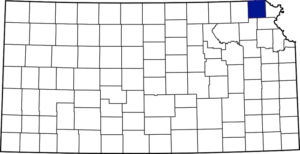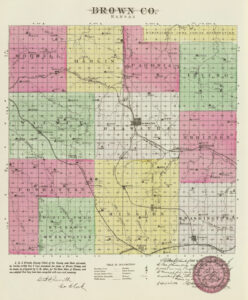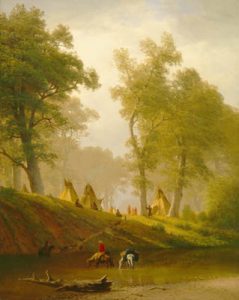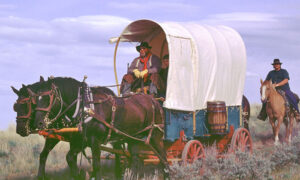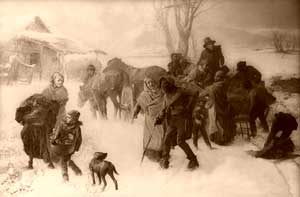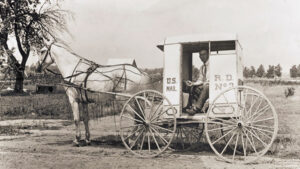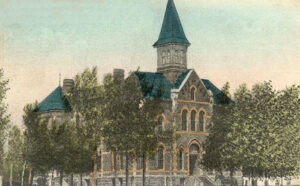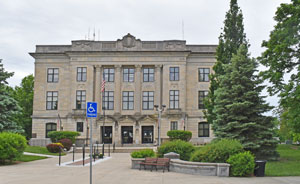Towns & Places:
Fairview
Hiawatha – County Seat
Horton
Morrill
Powhattan
Robinson
One-Room, Country, & Historic Schools of Brown County
Ioway Reservation
Kickapoo Indian Reservation of Kansas
Sac and Fox Reservation
Brown State Fishing Lake and Wildlife Area
Hiawatha Lake
Mission Lake
Brown County, Kansas, is located in the northeast portion of the state. It was one of the original 36 counties created by the Territorial Legislature in 1855. Its county seat and most populous city is Hiawatha. As of the 2020 census, the county population was 9,508.
The county first appeared to be spelled “Browne.” It was named after Albert G. Brown, a United States senator from Mississippi, who had spelled his name without the final “e.” However, Dr. John H. Stringfellow, a member of the Kansas legislature of 1855, stated that the county was named after O. H. Browne, a member of that legislature. In any event, subsequent legislatures dropped the final “e” in the spelling.
On September 17, 1855, the commissioners of Doniphan County passed the following resolutions: “That the county of Brown be and is hereby organized as a municipal township to be known as Brown County Township.” They ordered that the election for a delegate to Congress be held at the house of W.C. Foster on the south fork of the Nemaha River. The commissioners appointed William C. Foster and John C. Bragg, justices of the peace, and William Purket, constable. The following summer, an order was issued to survey the boundaries between Doniphan and Brown Counties, which was completed. In September, Brown County was divided into two townships, Walnut and Mission.
Brown County is bounded on the north by the State of Nebraska, on the east by Doniphan County, on the south by Atchison and Jackson, and on the west by Nemaha County. It has an area of 572 square miles. Cedar Creek well waters it in the southwest, Wolf Creek in the east, and numerous other creeks, the most important of which were Pony, Walnut, Roys, and Craig.
The county’s surface was gently undulating. The creek bottoms averaged about half a mile in width. All the streams were fringed with belts of timber, the principal varieties being oak, walnut, honey locust, hackberry, sycamore, elm, box-elder, and basswood. Limestone was abundant, and good-quality sandstone was found, both of which were quarried for local use. Two mineral springs in the western part of the county were claimed to have medicinal properties.
Part of the Oregon-California Trail wound along the divides passing Drummond’s Branch, crossed the western part of the present site of Hiawatha, followed the divide between the headwaters of Wolf and Walnut Rivers, and left the county near the present site of Sabetha.
Some of the first settlers in Brown County were Missourians who marked claims and then returned home to spend the winter, while others from a greater distance made permanent settlements. As early as April 10, 1854, William Gentry and H. C. Gregg settled in Powhattan Township. On May 11, 1854, Thurston Chase and James Gibbons were located on Wolf Creek. They were followed by William and James Metts, who settled in what is now Hamlin Township. On August 3, E. R. Corneilison entered a claim on Walnut Creek and brought his family to the new homestead the following March. His brother William also came at that time. W. C. Foster came to Brown County from Nemaha in the fall. John Belk, his sons William and King, and Thomas Brigham settled near Padonia, and Jacob Englehart settled on a farm not far from the present town of Hiawatha.
Early in the spring of 1855, the settlers on Walnut Creek formed a protective association, elected officers, and made rigid laws to enforce the rights of actual settlers and prohibit the sale of intoxicating liquors to the Indians. The first trial under these laws occurred at Jesse Padon’s house on the Walnut River bank. A complaint was made against Robert Boyd and Elisha Osborn for selling liquors to the Indians, and 16 settlers gathered, determined to enforce the law, the only settler absent from the gathering being ill. Although the accused were not present, the trial proceeded, they were declared guilty, and the verdict was that their stock of liquors should be destroyed and that they should each pay a fine of $20. Padon was appointed to execute the order of this court and was accompanied by all the settlers to see the decree enforced. Boyd and Osborn kept their liquors at the edge of Pilot Grove, some three miles from Padonia. When Padon informed them of the court’s decision, they declared themselves willing to give up the liquor and pay the fine. On a promise to sell no more to the Indians, they were allowed to remain in the county and retained the liquor, though they paid the fine.
A Methodist minister named Allspaugh held services in a grove near John Belk’s farmhouse in 1855. The first school was taught in 1856 in a log cabin erected the year before on John Kerey’s farm, and John Shields was the first teacher. The cabin was also used as a church, as the first religious services in the county were held there soon after it was built.
A branch of the Underground Railroad was established through Brown County for fugitive slaves, and John Brown and other abolitionists passed many over this line.
Early in 1857, the Methodists organized a church at the house of William Belk, and a Baptist minister held services at the residence of E.H. Niles.
On February 14, 1857, the state legislature detached Brown from Doniphan County and located the temporary county seat at Claytonville. The act also provided for the election of three commissioners to locate a permanent county seat. The new board of commissioners was organized on March 16, 1857, and, among other businesses, divided the county into four municipal Townships: Iowa, Claytonville, Walnut Creek, and Lachnane. On March 31, the commissioners held a second meeting. They appropriated $500 to build a courthouse on the north square in Claytonville — a frame building 20 by 30 feet — to be ready for occupation by June 1. William Oldham was appointed to build it.
Early in the spring of 1857, a colony arrived from Maine: George Ross, J. G. Leavitt, I. P. Winslow, Noah Hanson, W. G. Sargent, and Sumner Shaw. On June 4, 1857, the Iowa Indian trust lands in Brown County were advertised for sale to the highest bidders. They sold rapidly, but eventually, most of the lands fell into the hands of speculators. Some of the settlers left when they perfected the title to their claims without making any permanent improvements.
The first 4th of July celebration was held by a public gathering on John Powe’s farm on Mulberry Creek in 1857. Sometime during the summer of that year, Philip Weiss contracted to make a weekly trip to Iowa Point in Doniphan County to bring the mail. This was probably the first mail route in the county and was purely a private enterprise. He used a team of horses and a lumber wagon for his trips and carried passengers, express and freight, and mail.
The first post office was established at Claytonville on August 8, 1857, with George E. Clayton as postmaster.
At the election on October 5, 1857, the Free-State men carried the county by a vote of 136 to 72, F. N. Morrill being elected to the legislature by the counties of Brown and Nemaha. On November 16, the Free-State Board of County Commissioners was organized, and Ira H. Smith was chosen as county surveyor; David Peebles was clerk; and John S. Tyler was assessor. At the election, I. P. Winslow, Isaac Chase, and I. B. Hoover were chosen commissioners to locate the permanent county seat. They met on December 14 at Swain’s store, and the first ballot resulted in Padonia 1, Hiawatha 1, and Carson 1. The following day, the board visited the town sites of Carson, Hamlin, Padonia, and Hiawatha. Padonia offered to donate a square of ground and a $3,000 courthouse; Hiawatha offered to erect a building 20 by 30 feet for a courthouse and donate every alternate lot of the town site, and Carson offered one-half of the lots in the town site and $1,500 in labor and building material. A second ballot resulted in the same as the first, but on a third, two votes were cast for Carson and one for Padonia. The county seat, therefore, was removed to Carson. However, it did not remain there long, as the next legislature passed an act providing for an election to submit the question to a vote of the people, which resulted in 128 votes for Hiawatha and 37 for Carson, with a few scattering.
On May 25, 1858, the county commissioners appropriated $2,000 to build a courthouse with a jail and offices.
Though an act of 1855 provided for a mail route from St. Joseph, Missouri, via Highland to Marysville, Kansas, it was not started until 1858.
The first newspaper, the Brown County Union, was established by Dr. P. G. Parker in the spring of 1861 at Hiawatha, but the office was destroyed by fire the following winter.
At the outbreak of the Civil War in 1861, nearly half of the county’s voters entered the army, forming a party of Company I, Thirteenth Kansas infantry.
In 1864, the militia was ordered to gather at Atchison. The Hiawatha Company consisted of six men, the Walnut Creek Company of 41, and the Robinson Company of 100. Upon their departure to the front, the home guard was organized and, within 24 hours, had 79 men enrolled.
On August 20, 1864, H. P. Stebbins started the Union Sentinel newspaper.
The third newspaper in the county, the Hiawatha Dispatch, appeared in 1870.
On October 4, 1877, the county commissioners decided “That a proposition be submitted to the people on November 6, authorizing the board to build a new courthouse, the cost not to exceed $20,000.” The people approved this measure, and the commissioners, early in 1878, contracted with E. T. Carr of Leavenworth for its erection.
The second courthouse was a two-story brick structure built in 1879 for $20,000 by James A. McGonigle and designed by E. P. Carr. The first courthouse was demolished in 1880.
Brown County’s population peaked in 1900 at 22,369.
By 1910, the county had three railroad lines with over 97 miles of main track. The St. Joseph & Grand Island entered the county on the east, about midway north and south, crossed northwesterly through Hiawatha, and entered Nemaha County. A line of the Missouri Pacific Railroad, built in the early 1880s, crossed the northern boundary about the center, then through Hiawatha, and left at the southeast corner. The Chicago, Rock Island & Pacific Railroad entered in the south. It branched at Horton near the southern boundary, with one line leaving near the southeast corner, the other traversing the county in a northwesterly direction and connecting with the main line in Nebraska.
At that time, Hiawatha, the county seat, was a significant shipping point for all agricultural products and had several factories. However, Horton in the south was the largest town in the county, and it had the repair shops of the Chicago, Rock Island & Pacific Railroad located there. It was also the division point of that road.
In 1910, Brown County’s population was 21,314, and the total value of farm products, excluding livestock, was $2,921,381. The principal crops were corn, $1,920,240; hay, including all kinds, $428,716; oats, $394,522; Irish potatoes, $63,578; and wheat, $37,614. The county also had over 200,000 fruit trees of bearing age.
A third courthouse was built from 1925 to 1926 by contractor Harvey E. Wood. The three-story Neoclassical-style building is constructed of limestone and concrete. It is located on spacious landscaped grounds in the city’s center and is part of the Hiawatha Courthouse Square Historic District.
Brown County remained primarily agricultural in the following decades, and its population gradually declined.
Brown County is the location of the Kickapoo Indian Reservation of Kansas, the majority of the Sac and Fox Reservation, and the majority of the Iowa Reservation of Kansas and Nebraska.
©Kathy Alexander/Legends of Kansas, updated November 2024.
Also See:
Sources:
Blackmar, Frank W.; Kansas: A Cyclopedia of State History, Vol I; Standard Publishing Company, Chicago, IL 1912.
Cutler, William G; History of Kansas; A. T. Andreas, Chicago, IL, 1883.
Wikipedia


